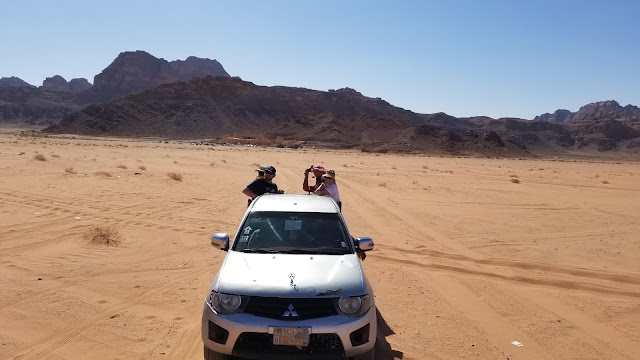Petra
Today we started with what is, no doubt, the premier site in Jordan, the
fabulous ruins of the Nabatean city of
Petra.
The Nabateans were an
early Arab people who moved into much of the territory of the Old
Testament kingdom of Edom (the Edomites, in the Persian period, moved
into the southern part of OT Judah and became the Idumeans of the New
Testament). They expanded their territory east, south, and into the
Sinai and became incredibly wealthy in the first centuries before and
after Christ because of their acumen as merchants and in particular
because of their control of the spice trade.
They built their capital in a sunken valley surrounded by high mountains
that had only one way in and out, the narrow cleft valley known as the Siq. Approaching the siq
and in the valley itself are hundreds of tombs cut right into the rock
face, many of them incredibly ornamented.
 |
| Some free-standing tombs were known by later Beduin as Djinn Blocks because they thought desert spirits dwelt in them |
 |
| The Nabateans were quite eclectic, borrowing motifs from many surrounding cultures. This tomb, for instance, incorporates and Mesopotamian motif of double stairways to heaven, allowing souls to ascend to their rewards. |
 |
| A Nabatean inscription |
 |
| This tomb includes obelisks influenced by Egypt |
The
siq is kind of a winding slot canyon, often quite narrow. Along the way there are water channels and small shrines that provided for both the physical and spiritual needs of visitors to the city. Then as the
siq suddenly turns, a narrow view of the most famous of the rock cut tombs, the
so-called Treasury, appears. It is probably best known from its appearance in the Indiana Jones movie
The Last Crusade.
 |
| The entrance to the siq |
 |
| Water channel |
 |
| Shrine niche Dushara |
 |
| Here it comes! |
 |
| The many tombs, monuments, and temples of ancient Petra |
Because we only had about 5 hours (not that much time for such a huge,
interesting site that requires a lot of walking and climbing), after we
did the usual introductory approach to the Treasury, we kind of hurried
through the city area, looking briefly at the theater cut into the hill,
the Great Temple, and the interesting Egyptian-influenced building now
called
Qasr-al-Bint ("Palace of the Daughter," ostensibly built
for a daughter of a Pharaoh, though that is necessarily an anachronistic
and incorrect identification).
 |
| Qasr al-Bint |
Wadi Rum
This desert valley was known as "The Valley of the Romans" (Arabic,
وادي رم)
perhaps because many ascetic Byzantine monks (remember Byzantines =
Greek-speaking, Christian Romans) withdrew to isolated spots like this
to get away from the world and be with God. Because it is in so many
ways a quintessential Arabian desert, movies such as "Lawrence of
Arabia" and recently "The Martian" were filmed here.
We all piled into 4x4 pickup trucks and went on a mad drive through the sand. We stopped to look at interesting,
really
an ancient carvings of the mysterious Thamudic culture (kind of like
the American Anastazi). We also stopped at a magnificent canyon lookout
that gave us a view of the vast Plains of Midian, which gave us a chance
to talk about the wanderings of the Children of Israel in the
wilderness.
A Beduin Feast
Then we went to a Beduin camp for a feast and to watch some dancing. It was quite a day!










































No comments:
Post a Comment